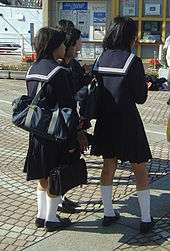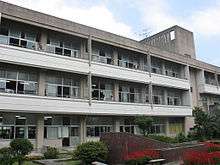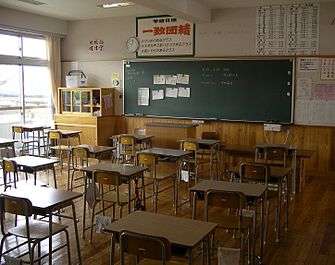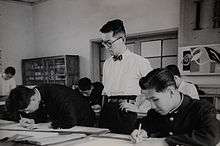Secondary education in Japan
Secondary education in Japan is split into junior high schools (中学校 chūgakkō), which cover the seventh through ninth grade, and senior high schools (高等学校 kōtōgakkō, abbreviated to 高校 kōkō), which mostly cover grades ten through twelve.

Junior high school


Lower-secondary schools cover grades seven, eight, and nine. Ages are roughly 12-15 with increased focus on academic studies. Although it is possible to leave the formal education system after completing lower secondary school and find employment, fewer than 4% did so by the late 1980s.
Most junior high schools in the 1980s were government-funded public schools; 5% were private schools. At ¥552,592 ($3,989 USD) per pupil, private schools had a per-student cost that was four times as high as public schools, at ¥130,828 ($934 USD).[1]
The minimum number of school days in a year is 210 in Japan, compared to 180 in the United States. A significant part of the school calendar is taken up by non-academic events such as sports days and school trips.[2]
Teachers often majored in the subjects they taught. Each class is assigned a homeroom teacher who doubles as counselor. Unlike elementary students, junior high school students have different teachers for different subjects. The subject teachers usually move to a new room for each 50-minute period. Usually students' lunch is provided by the school itself.
Instruction
Instruction tends to rely on the lecture method. Teachers also use other media, such as television and radio, and there is some laboratory work. By 1989 about 45% of all public lower-secondary schools had computers, including schools that used them only for administrative purposes. Classroom organization is still based on small work groups, although no longer for reasons of discipline. Students are expected to have mastered daily routines and acceptable behavior.
All course contents are specified in the Course of Study for Lower-Secondary Schools. Some subjects, such as Japanese language and mathematics, are coordinated with the elementary curriculum. The curriculum covers Japanese language, English, social studies, mathematics, science, music, fine arts, industrial arts, homemaking, health, and physical education. Moral education and special activities continue to receive attention.[3]
Extracurricular activities
Many students participate in after-school clubs. Sports clubs, such as baseball are especially popular among boys,[4][5] while wind bands are one of the most popular clubs for girls.[5] Soccer (football) clubs are gaining popularity. Judo clubs attract boys and girls. Other popular sports clubs include tennis, basketball, gymnastics, and volleyball. In every sport, many games are held between schools and at the regional level, so students have opportunities to compete.
For cultural clubs, choir and art clubs, brass band, tea ceremony, and flower arrangement clubs are popular.[4]
Some junior high schools encourage students to take academic ability tests such as the STEP Eiken for English or the Kanji kentei for Japanese.
Students in the highest grades of elementary, junior high, and senior high schools also take trips lasting up to several days to culturally important cities such as Kyoto and Nara, ski resorts, or other places.[4]
Senior high school

Even though upper-secondary school is not compulsory in Japan, as of 2005 94% of all junior high school graduates entered high schools[6] and over 95% of students graduated successfully from them compared to 89% of Americans.[7]
To enter, students must take an entrance examination in Japanese, mathematics, science, social studies, and English,[8] whether it is standardized for all public high schools in the prefecture or a test created by a private high school for that school alone.[8] All upper-secondary schools, public and private, are informally ranked based on their success in placing graduates in freshman classes of internationally ranked and Imperial Universities.[8] Success or failure on an entrance examination can influence a student's entire future, since the prospect of finding a good job depends on the school attended. Thus, students experience the pressure of this examination system at a relatively early age.[8] Because of the importance of these exams in entering high school — even more than the scholastic record and performance evaluations from lower-secondary school — students are closely counselled in lower-secondary school so that they will be relatively assured of a place in the schools to which they apply.
Daily life
Students walk, ride bicycles, or take public transportation to school.[8] What they can do on the way to and from school — chewing gum, consuming snacks, reading books while walking — anything that might reflect badly on the reputation of the school[8] is regulated by some schools to protect that reputation.[8] Many schools have a unique uniform that makes its students easily identifiable to the public.[8]
High schools typically begin at 8:30,[8] when teachers meet for a five-minute meeting, followed by homeroom.[9] Students assemble in their homerooms of an average of between 40 and 45 students each,[8] Homeroom teachers are in charge of morning or afternoon homeroom times, about five minutes each, as well as a weekly long homeroom period.[10]
The latter meeting "provides an opportunity for teachers to concentrate on student guidance. Typical activities include helping students develop greater awareness of themselves as high school students, encouraging them to reflect on their summer vacations, or perhaps asking them to contemplate the forthcoming advancement from one grade to another."[9]
During the daily homerooms the students themselves conduct what they call "toban" — taking attendance, making announcements, etc. — that are shared on a rotating basis.[8] Many students are assigned to specific task committees in their homeroom class.[10]
There are four classes of 50 minutes each before lunch.[9] Students go to different classrooms for physical education, laboratory classes, or other specialized courses; otherwise, teachers change classrooms instead of the students for the entire day.[8] Students typically attend between ten and fourteen courses a year.[11]
Some schools do not have their own cafeteria, so students generally eat in their homerooms instead.[9] Unlike students in elementary and middle school, high school students do not have government-subsidized lunches.[10] Because of this, many students bring a box lunch (bento) - from home with foods such as rice, fish, eggs, and vegetables.[8][10] After lunch students have two more classes.[9]
Typically at 3:30 PM, students are free to attend extracurricular activities.[8][9]
Saturday schooling, when offered, ends at 1 PM after four courses.[9]
Extracurriculars
In most schools, there are two types of extracurricular clubs:
- sports clubs, such as baseball, football, judo, kendo, track, tennis, swimming, softball, volleyball, and rugby;
- culture clubs, such as English, broadcasting, calligraphy, science, mathematics.[8]
New students usually choose a club after the school year begins and only rarely change for the rest of their high school careers.[8] Clubs meet for two hours after school every day, many times even during school vacations.[8] Although there is a teacher assigned to each club as a sponsor, they often have very little input in the club's daily activities.[8] These clubs are an important chance for students to make friends and learn the social etiquette and relationships like the "senpai" (senior)/"kohai" (junior) dynamic that will be important in their adult lives.[8]
However, most college bound students withdraw from club activities during their senior year to devote more time to preparation for university entrance examinations.[8] Homeroom teachers work with students and their parents at this time to discuss their admission prospects or career plans.[10]
Curriculum
As of the late 1990s Japanese students spent 240 days a year at school, 60 days more than their American counterparts[8] even with the amount of time spent preparing for school festivals and events.[2][8] Traditionally Japanese students attended class on Saturdays;[8] although education reforms from 2002 have made them no longer mandatory,[7] many schools have begun to bring them back to have more time to cover the rigorous material required by the Ministry of Education.
Schools have limited autonomy in developing their curriculum or choosing their textbooks. Instead, although the latter are written and produced in the private sector,[7] the Ministry of Education has the final say over any and all content and materials.[8] Typically students take three years each of mathematics, social studies, Japanese, science, and English, with additional courses including physical education, music, art, and moral studies.[7] In particular social studies in Japan is broken down into civics, geography, Japanese history, world history, sociology, and politics/economics.[7]
There are the large number of mandatory courses, and a few number of electives. All the students in one grade level study the same subjects,[8] although it is in upper-secondary school that differences in ability are first publicly acknowledged.
Upper-secondary teachers are university graduates. Upper-secondary schools are organized into departments, and teachers specialize in their field of study although they teach a variety of courses sharing a more general discipline. Teaching depends largely on the lecture system, with the main goal of covering the curriculum. Approach and subject coverage tends to be uniform, at least in the public schools.
Education reforms
| International educational scores (latest, 2007) (8th graders average score, TIMSS International Math and Science Study, 2007) | ||||||
| Countries: (sample) |
Global rank |
Maths | Science | |||
| Rank | Score | Rank | Score | |||
| 1 | 3 | 593 | 1 | 567 | ||
| 2 | 1 | 598 | 2 | 561 | ||
| 3 | 2 | 597 | 4 | 553 | ||
| 4 | 5 | 570 | 3 | 554 | ||
| 5 | 4 | 572 | 9 | 530 | ||
| 6 | 6 | 517 | 6 | 539 | ||
| 7 | 7 | 513 | 5 | 542 | ||
| 8 | 11 | 504 | 7 | 539 | ||
| 9 | 8 | 512 | 10 | 530 | ||
| 10 | 12 | 501 | 8 | 538 | ||
| 11 | 9 | 508 | 11 | 520 | ||
| 12 | 10 | 506 | 12 | 519 | ||
| 13 | 14 | 496 | 13 | 515 | ||
| 14 | 15 | 491 | 14 | 511 | ||
| 15 | 13 | 499 | 17 | 488 | ||
| 18 | 19 | 480 | 16 | 495 | ||
| Maths Highlights from TIMSS 2007 Science Highlights from TIMSS 2007 | ||||||
The Ministry of Education, Culture, Sports, Science and Technology (MEXT) recognizes a need to improve the teaching of all foreign languages, especially English. To improve instruction in spoken English, the government invites many young native speakers of English to Japan to serve as assistants to school boards and prefectures under its Japan Exchange and Teaching Program. By 2005 participants numbered over 6,000. In the last few years, several school boards in Japan have relied on ALTs (Assistant Language Teacher) from private dispatch companies.
As part of the movement to develop an integrated curriculum and the education reform movement of the late 1980s, the entire Course of Study for Lower-Secondary Schools was revised in 1989 and took effect in the 1992–93 school year. A main aim of the reform is to equip students with the basic knowledge needed for citizenship. In some measure, this means increased emphasis on Japanese history and culture, as well as understanding Japan as a nation and its relationships with other nations of the world. The course of study also increased elective hours, recommending that electives be chosen in light of individual student differences and with an eye toward diversification.
A further revision to the Fundamental Law of Education was carried out on 22 December 2006.[12] The revised law leaves the structure of schooling basically the same but includes new emphases on respect for Japanese culture (Article 2.5), school discipline (Article 6.2), and parental responsibility (Article 10).[13]
Junior high issues
Two problems of great concern to educators and citizens began to appear at the lower-secondary level in the 1980s: bullying, which remains a major problem, and the school-refusal syndrome (toko kyohi; manifested by excessive absenteeism), which was on the rise.[14] In 2008, there were 42,754 incidents of problematic behavior in junior high schools, according to a government survey.[15]
Experts disagreed over the specific causes of these phenomena, but there is general agreement that the system offers little individualized or specialized assistance, thus contributing to disaffection among those who can not conform to its demands or who are otherwise experiencing difficulties. Another problem concerns Japanese children returning from abroad. These students, particularly if they have been overseas for extended periods, often need help in reading and writing — and in adjusting to rigid classroom demands. Even making the adjustment does not guarantee acceptance. Besides having acquired a foreign language, many of these students have also acquired foreign customs of speech, dress, and behavior that mark them as different.
Senior high issues
The upper-secondary curriculum underwent thorough revision in 1989. That year a new Course of Study for Upper-Secondary Schools was announced that was to be phased in beginning with the tenth grade in 1994, followed by the eleventh grade in 1995 and the twelfth grade in 1996. Among noteworthy changes is the requirement that male and female students take a course in home economics. The government is concerned with instilling in all students an awareness of the importance of family life, the roles and responsibilities of family members, the concept of cooperation within the family, and the role of the family in society. The family continues to be an extremely important part of the social infrastructure, and the ministry clearly is interested in maintaining family stability within a changing society. Another change of note was the division of the old social studies course into history-and-geography and civics courses.
Notes
- A., Fadul, Jose (2011). Insights from emergent education systems in selected countries : with De La Salle-College of Saint Benilde School of Multidisciplinary Studies scenarios upon full implementation of the K-12 program by 2016. Morrisville, North Carolina: Lulu Press, Inc. ISBN 9781257995219. OCLC 957970329.
- Shields, James J. (31 May 2004). Japanese Schooling: Patterns of Socialization, Equality, and Political Control. Penn State Press. pp. 82–84. ISBN 978-0-271-02340-3. Retrieved 16 November 2012.
- With a Mighty Hand, New Republic, March 19, 2011.
- http://web-japan.org/kidsweb/explore/schools/index.html
- Wind Bands and Cultural Identity in Japanese Schools by David G. Hebert (Springer press, 2011).
- STATISTICAL ABSTRACT 2006 edition<"Archived copy". Archived from the original on 2008-06-17. Retrieved 2008-06-04.CS1 maint: archived copy as title (link)>
- http://www.unc.edu/world/2006_K12Symp/Post-Program/Middle_Lesson_Plan.pdf
- Marcia, Johnson L. and Jeffrey R. Johnson. "Daily Life in Japanese High Schools." ERIC Digest. October 1996. ERIC Identifier: ED406301.
- http://members.tripod.com/h_javora/jed8.htm
- Japanese Education in the 21st Century, Miki Y. Ishikida, June 2005, p. 101
- "Archived copy". Archived from the original on 2015-08-23. Retrieved 2015-08-25.CS1 maint: archived copy as title (link)
- "MEXT : Basic Act on Education (Provisional translation)". The Ministry of Education, Culture, Sports, Science and Technology. Archived from the original on March 31, 2016. Retrieved April 19, 2016.
- Comparison of old and current law on Japan Focus an Asian Pacific e-journal] accessed at December 11, 2008
- Free to Be by Miki Tanikawa, The New York Times January 12, 2002
- Yomiuri Shimbun 2/12/2009
References
- Reed, Steven R. Japanese Prefectures and Policymaking. University of Pittsburgh Press, July 15, 1986. ISBN 0822976412, 9780822976417.
Further reading
- Benjamin, Gail. Japanese Lessons: A Year in a Japanese School through the Eyes of an American Anthropologist and Her Children. New York: New York University Press, 1998.
- DeCoker, Gary, editor. National Standards and School Reform in Japan and the United States. New York: Teachers College Press, 2002.
- Ellington, Lucien. "Beyond the Rhetoric: Essential Questions about Japanese Education." Footnotes, December 2003. Foreign Policy Research Institute's website: http://www.fpri.org
- Eades, J.S. et al., editors. The 'Big Bang' in Japanese Higher Education: The 2004 Reforms and the Dynamics of Change. Melbourne: Trans Pacific Press, 2005.
- Fukuzawa, Rebecca Erwin and Gerald K. Letendre. Intense Years: How Japanese Adolescents Balance School, Family, and Friends. New York: Routledge Falmer, 2000.
- Goodman, Roger and David Phillips, editors. Can the Japanese Change Their Education System? Oxford: Symposium Books, 2003.
- Guo, Yugui. Asia's Educational Edge: Current Achievements in Japan, Korea, Taiwan, China, and India. New York: Lexington Books, 2005.
- Letendre, Gerald K. Learning to Be Adolescent: Growing Up in U.S. and Japanese Middle Schools. New Haven: Yale University Press, 2000.
- Masalski, Kathleen. (2001). "Examining the Japanese History Textbook Controversies." A Japan Digest produced by the National Clearinghouse for U.S.-Japan Studies. Full text at http://www.indiana.edu/~japan/Digests/textbook.html.
- Rohlen, Thomas P. JAPAN'S HIGH SCHOOLS. Berkeley: University of California Press, 1983. ED 237 343.
- Seo, Kanehide. THE LIFE OF A SENIOR HIGH SCHOOL STUDENT. Tokyo: International Society for Educational Information, 1986.
- Tomlinson, Tommy. "Hard Work and High Expectations: Motivating Students to Learn." Issues in Education. Office of Educational Research and Improvement, Washington, D.C. Report. April 1992. ED 345 871
- White, Merry. THE MATERIAL CHILD: COMING OF AGE IN JAPAN AND AMERICA. New York: The Free Press, 1993.
- Wray, Harry. Japanese and American Education: Attitudes and Practices. Westport, Conn.: Bergin and Garvey, 1999.
